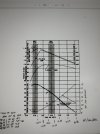How does a spark plug become weak? Is a strong spark plug simply a cleaned/new one, or a specific type?
Every plug has an internal resistor to cut the spark off rather than let it trickle to a stop as the voltage diminishes. This is to reduce electrode erosion. Those resistors have been troublesome in the past, notably in the Champion plugs made up until six or eight years ago. Those had a little resistor pellet that was dropped into the plug, then a small spring on top, and the whole thing held in by a screw. You can see the slot in that screw at the bottom of the connector well. Vibration and heat made that resistor move around, messing up its contacts at either end, and the plugs would fail on the pressure tester after cleaning and gapping. Plugs are supposed to spark to at least 135 PSI. That pressure tester is also supposed to be calibrated so that its voltage, and the gauge's accuracy, are where they are supposed to be.
Auburn was a sparkplug maker that had the best plugs. Their resistor was molded in securely. Those plugs would last many times longer than a Champion. So Champion bought Auburn and shut them down. Tempest and AC started making integral-resistor plugs, and they were nearly as good as the Auburns, but Champion kept insisting that their plugs were just fine. Eventually they finally quietly changed to the Auburn technology they had owned for a decade or more, and their problems seemed to clear up.
This is the reason for resistance checks when cleaning up the plugs. That resistor should have between 1000 and 5000 ohms. Those old Champs would often read infinity, and Champion kept telling us that this was no problem. Yeah, right. Infinity means there's arcing going on in there, and it's not going to get better.
The pressure check will also reveal a cracked ceramic insulator. You'll sometimes hear the crackling of an arc in the well. A contaminated well can do it too, with the spark travelling along the surface to the steel shell at the connector end. The spark at the electrodes will stop while this is happening.
A magneto that hasn't been maintained properly will deliver a weak spark and cause roughness. Most of the time this is due to erosion of the points and/or wear of the cam or rubbing block. This alters the E-gap, the angle of the rotor past neutral when the points open, and the spark generation is weaker.
Too many folks think a spark is a spark. Nope. A weak spark will reduce power, cause bigger mag drops, roughness when lean, and so on. A nice hot spark is what you want. There is no fooling around in that cylinder when a hot spark zaps the mixture.
The ignition harness leads are also a factor here. There is a tester for that.




